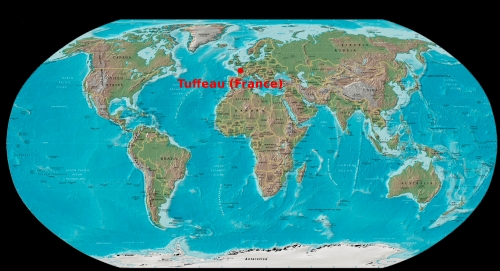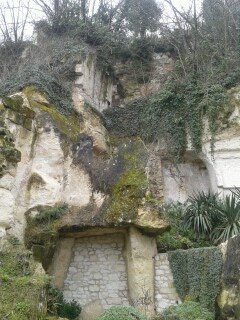The limestone of the Loire Valley .. EarthCache
The limestone of the Loire Valley ..
-
Difficulty:
-

-
Terrain:
-

Size:  (other)
(other)
Please note Use of geocaching.com services is subject to the terms and conditions
in our disclaimer.
The limestone of the Loire Valley ..

Fresh and bright, the birthplace of the great vineyards, tufa stone sign the cultural identity of the Loire Valley through its many castles, abbeys, towns and villages.
Anglais...
The limestone is a marine sedimentary rock outcrops in the southwestern area of the Paris basin, the Loire Valley ... The limestone consists of the remains of organisms and fragments of rock brought to the sea by rivers as alluvium. Aged? millions of years, deposited sediments which have subsided, pressure, allowed their recrystallization and cementation. The limestone is a result of the long and slow processing of the sediment in rock by cementing these particles fossil. Today, the Tuff operated (Tuff says white) is available in regular and consistent benches to a depth of up to 40 m!
VALIDATION CACHE: To validate this cache: you must answer the following questions, and you go there for the photo ...
1) Age and age of onset of tufa?
2) What you fossils found in the limestone?
3) Quest that muscovite?
4) limestone porosity in%?
5) Photo of you or your GPS coordinates to the career ... (optional !!!)
Send your answers by email (via my profile) and do not forget to put the picture in your journal

You can spice this ERTHCACHE by visiting CAREER Vignemont ...
vignemont37@carriere de vignemont.fr. 
Français ..
Le Tuffeau est une roche sédimentaire marine qui affleure dans la zone sud-ouest du bassin parisien, le Val de Loire… Le Tuffeau est constitué de restes d'organismes et de fragments de roches apportés jusqu'à la mer par les cours d'eau sous forme d'alluvions. Agé de ? millions d'années, les sédiments déposés ont subi un tassement qui, par pression, a permis leur recristallisation et leur cimentation. Le Tuffeau est le résultat de cette lente et longue transformation du sédiment en roche par cimentation de particules fossiles entre elles. Aujourd'hui, le Tuffeau exploité (dit Tuffeau blanc) se présente en bancs réguliers et homogènes sur une épaisseur pouvant aller jusqu'à 40 m !
VALIDATION CACHE: Pour valider cette cache: vous devez répondre aux questions suivantes, et vous rendre sur place pour la photo...
1) Ere et age d'apparition du tuffeau ?
2) Quels fossiles trouve t'on dans le tuffeau ?
3) Quest ce que la muscovite ?
4) Porosité du tuffeau en % ?
5) Photo de vous ou votre GPS aux coordonnées devant la carrière... (facultatif !!!)
Envoyez vos réponses par courriel (via mon profil) et n'oubliez pas de mettre la photo dans votre journal. ...
Additional Hints
(No hints available.)